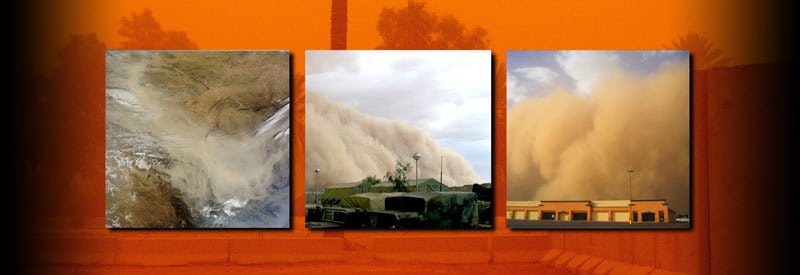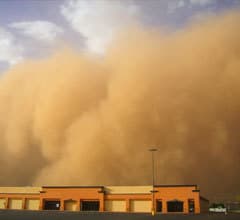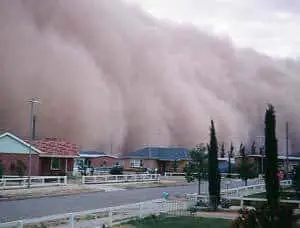Dust Storms – What They Are And How They Develop

Readers residing in arid or semi-arid regions, which are characterized by loose, dry soil, will be very familiar with dust storms. However, this is a meteorological event that affects everyone on a global scale.
A dust storm is defined as a meteorological phenomenon that primarily occurs in arid and semi-arid regions when large sections of loose dirt and sand are picked up by strong winds and blown into the air. This creates a dense wall of dust that can stretch for miles and thousands of feet in height.
Dust storms can affect regions thousands of miles away. In fact, it can even cross oceans and affect countries on other continents. Dust from the Sahara Desert in Africa can reach as far as the Amazon in South America and even parts of the United Kingdom.
We mostly associate dust storms with their negative effect on humans and the environment. However, they also have some unexpected positive impacts in some regions, as you will learn in a later section.
This article will examine what a dust storm is, how it is formed, and what its effects are. We also take a brief look at how often this phenomenon occurs.
Dust Storm Definition
Before one can start examining how a dust storm develops, we first need to define what precisely a dust storm is:
What Is A Dust Storm?

A dust storm is defined as a meteorological event that primarily occurs in arid and semi-arid regions when large sections of loose dirt and sand are picked up by strong winds and blown into the atmosphere. It creates a dense wall of dust that can stretch for miles and be thousands of feet in height.
Also called a sandstorm, this meteorological occurrence creates a wall of dust that can stretch for miles and be thousands of feet high. Strong winds can transport and displace large quantities of dust or sand over hundreds or thousands of miles during this process.
Even though many regard dust and sandstorms as the same phenomenon, dust particles are smaller and lighter, allowing them to be lifted higher into the atmosphere and travel over longer distances.
What Causes A Dust Storm?
For a dust storm to occur, the right conditions must be in place. These conditions include very loose pieces of dirt or sand, preferably spread out over a relatively large flat space. The vital component, though, is a strong wind to start and maintain the process.
The winds responsible for a dust storm normally originate from a thunderstorm or a strong pressure gradient. (A strong pressure gradient happens when air changes from an area of high to low pressure over a short distance, resulting in a strong wind.)

As the wind blows over the ground, it loosens and picks up pieces of soil, which allows them to start to creeping and speed up and even briefly become airborne.
This leads to a process called saltation (where dirt gets picked up into the air before falling back to the ground). Each time a piece of soil hits the ground, it gets broken down into smaller parts.
Once the dust particles are small enough, it stays suspended in the air. The process takes place over a large area, where billions upon billions of dust particle gets picked up and mobilized by the wind. This process creates the thick wall of dust we know as a dust storm.
At any time during the creation of a dust storm, the creeping, saltation, and suspension of dust particles into the air all take place simultaneously to create this storm system.
Human activities further contribute to the creation of dust storms. Deforestation is leaving increasingly large areas of the Earth exposed to drying out. Large-scale crop farming in semi-arid regions also leaves thousands of hectares of dry soil exposed when no crops are planted.
Effects Of A Dust Storm
Dust storms have several widespread consequences. Many of the well-documented repercussion is also well-known, but there are also one or two unexpected benefits. Some of the most important effects of a dust storm include:
1) Structural And Vegetation Damage
The combination of strong winds and dust particles of different sizes can cause severe damage to houses, buildings, and structures. Dust and sand can also bury large parts of a city or town, especially low-lying areas like streets, motor vehicles, and smaller structures.
Some dust storms are strong enough to blow over trees and completely remove large sections of vegetation. It can also have a devastating effect on the agricultural sector, where entire crops can be destroyed over large areas.
2) Desertification
Desertification is the process through which changes in climate, as well as human activities, cause a growing section of the planet to turn into deserts.
The irony of this process is that desertification allows for more dust storms to occur. In return, these storms remove large portions of topsoil from neighboring regions, which further contributes to the desertification process.
3) Effect On Human And Animal Life
People caught in dust storms can experience short-term effects like impaired vision, burning throats, and difficulty breathing. Larger sand particles can cause abrasions and irritation of the skin. In severe cases, some of these effects can have long-term consequences.
One of the serious consequences, though, is the damage to the human respiratory system. Dust storms can seriously affect people with existing respiratory problems, but long-term exposure to dust can also lead to the development of new related ailments.
Animals in the open don't have the same protection humans do, which means a significant number of these creatures perish during a dust storm. It leads to a substantial loss in livestock in areas frequently hit by dust storms. Wildlife is unfortunately also not immune.
4) Reduced Visibility

As is the case with dense fog and blizzards, a dust storm can dramatically reduce visibility. This has a severe impact on all kinds of transport, especially road and air traffic.
It can be so severe that roads may be forced to close and flights delayed or canceled. In the long term, it has a negative effect on the larger economy as well.
5) Fertilization Of The Amazon
As mentioned at the start of this section, a dust storm can have a positive impact as well. Large storms can transport dust over vast distances, especially when carried by winds in the upper atmosphere. It can even reach as far as the Amazon Rain Forest in South America.
The deposition of dust (soil particles) in the Amazon leads to a welcome replenishment of soil and also helps to fertilize the ground. This process helps to sustain and promote plant and tree growth in this critical part of the Earth.
How Long Do Dust Storms Last?
They may be big and impressive, but dust storms do not last nearly as long as you might expect. They usually last for a few minutes, and at the most, an hour.
However, some dust that gets kicked up in the atmosphere stays over cities and towns for days and weeks, contributing to the air pollution in the region. If it gets caught by winds in the upper atmosphere, it can also be transported over longer distances, as you already saw.
Conclusion
As you might have realized while reading this post, dust storms may not last that long, but they pack a powerful punch and cause a lot of disruption and damage over a short period.
After reading this article, you will know exactly what a dust storm is, how it is formed, and its effects on the environment and human/animal life.
Never miss out again when another interesting and helpful article is released and stay updated, while also receiving helpful tips & information by simply clicking on this link .
Until next time, keep your eye on the weather!
